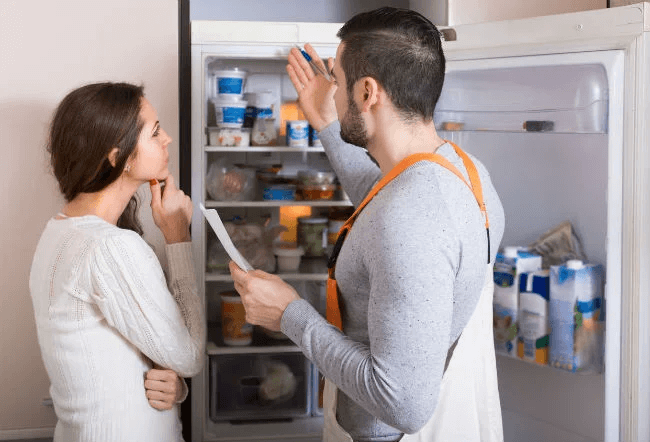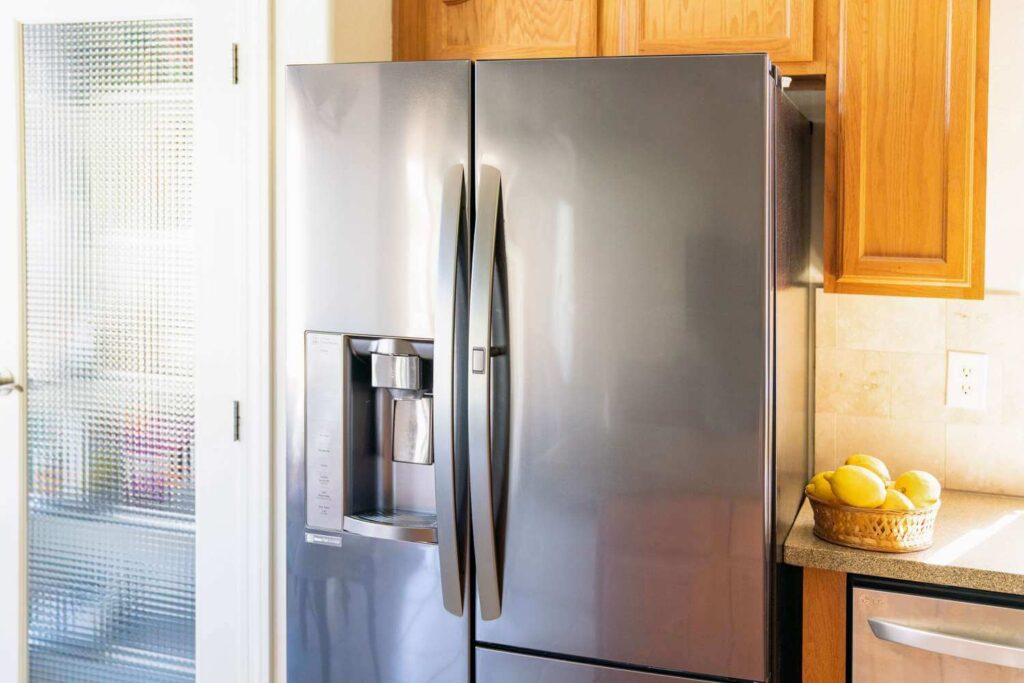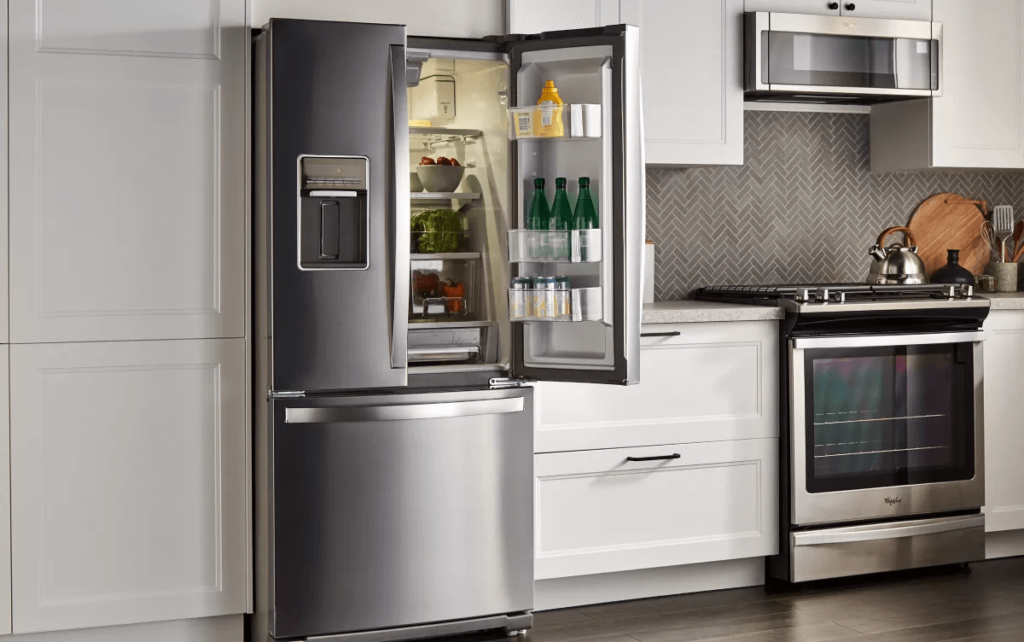
Is your trusty old refrigerator feeling more like a heated storage unit rather than a reliable chill box? Don’t fret, you’re not alone in this cooling conundrum. In this in-depth guide, we’ll explore the various reasons your refrigerator might not be cooling as it should and provide detailed troubleshooting and repair tips to get it back in tip-top shape.
Understanding the Fridge’s Cooling System
Before we dive into the troubleshooting, let’s take a moment to understand how a typical refrigerator cooling system works. This knowledge will help you identify and fix the issues more effectively.
Your refrigerator relies on a closed-loop system that uses a refrigerant, usually a gas like Freon, to transfer heat from the inside to the outside. Here’s a simplified breakdown of the key components:
- Compressor: This is the heart of the system, responsible for compressing the refrigerant gas, raising its temperature, and sending it to the condenser.
- Condenser Coils: The hot, pressurized gas from the compressor passes through these coils, releasing heat and transforming it into a high-pressure liquid.
- Expansion Valve: The high-pressure liquid then flows through the expansion valve, where it undergoes a sudden drop in pressure, causing it to evaporate into a cold gas.
- Evaporator Coils: The cold gas circulates through these coils inside the refrigerator, absorbing heat from the interior and cooling it down.
- Evaporator Fan: This fan blows air over the evaporator coils, spreading the cold air throughout the fridge to keep your food and drinks cool.
- Thermostat: The thermostat regulates the temperature by signaling the compressor to cycle on and off as needed to maintain the desired level of cooling.
Common Culprits for a Warm Refrigerator
Now that we have a basic grasp of the cooling system, let’s explore the common issues that can disrupt your refrigerator’s cooling capabilities and the steps to resolve them.
Dirty Condenser Coils
Symptoms: Warm fridge, excessive heat around the back or underneath.
Solution: Over time, dust and debris can accumulate on the condenser coils, inhibiting heat dissipation. Here’s how to deal with it:
- Safety First: Unplug the refrigerator and ensure it’s disconnected from power.
- Locate the Coils: These coils are typically situated at the back or underneath the refrigerator.
- Clean the Coils: Use a vacuum cleaner or a coil brush to gently remove the dust and dirt. Ensure thorough cleaning.
Faulty Thermostat
Symptoms: The refrigerator temperature doesn’t change even if you adjust the thermostat settings.
Solution: The thermostat might be the culprit. Here’s what you can do:
- Adjust the Thermostat: Set the thermostat to a lower temperature and wait for a few hours. If there’s no change, proceed to the next step.
- Replace the Thermostat: If the temperature remains unchanged, it’s time to replace the thermostat. Consult your refrigerator’s manual for the right part and follow the manufacturer’s instructions.
Inadequate Air Circulation
Symptoms: Uneven cooling inside the fridge, warm spots, or excess condensation.
Solution: Proper airflow is crucial for maintaining consistent cooling. Ensure there’s enough space around your refrigerator for ventilation.
- Reposition the Fridge: Make sure the fridge isn’t too close to the wall or other appliances. Allow a gap of at least 2-3 inches on all sides for adequate air circulation.
Blocked Vents
Symptoms: Some areas in your refrigerator are colder than others, and you can’t feel air coming out of all vents.
Solution: The blocked vents could be restricting air circulation. Here’s how to address this issue:
- Inspect Vents: Check for any obstructions near the vents inside the refrigerator, such as food items or containers that might be blocking the airflow.
- Rearrange Items: Rearrange your food and items to allow better air circulation. Ensure there’s space between items, especially near the vents.
Defective Evaporator Fan Motor

Symptoms: No cold air circulating in the refrigerator, even though the compressor is running.
Solution: When the evaporator fan motor goes bad, it affects the distribution of cold air. Follow these steps:
- Listen for the Fan: Open the refrigerator and listen for the sound of the fan. If it’s silent, it’s a strong indicator that the motor is malfunctioning.
- Replace the Fan Motor: You’ll need to replace the fan motor if it’s not working. Consult your refrigerator’s manual or the manufacturer’s website for the specific replacement part and installation instructions.
Dirty or Damaged Door Seals
Symptoms: You notice cool air escaping from around the refrigerator door when it’s closed.
Solution: Faulty door seals can cause your refrigerator to work harder to maintain its temperature. Here’s what to do:
- Check the Seals: Inspect the rubber door seals for any visible damage or signs of wear.
- Dollar Bill Test: Perform the dollar bill test by placing a dollar bill in the door and closing it. If you can easily pull it out, the seals need replacement.
- Replace the Seals: If the seals are damaged or no longer seal properly, purchase replacement seals from the manufacturer and follow their instructions to install them.
Pro Tips for Diagnosing the Issue
Sometimes, the issues go beyond the obvious culprits mentioned above. Here are some additional tips for diagnosing and resolving cooling problems.
Is it Power Trouble?
Symptoms: The refrigerator is unresponsive, and the light doesn’t turn on.
Solution: Start with the basics – check if the fridge is plugged in, and the outlet is providing power. If the light doesn’t come on, the issue might be electrical. Inspect the power cord and the circuit breaker to ensure everything is in working order.
The Thermostat Tango
Symptoms: The refrigerator is running, but it’s not cold enough.
Solution: If the refrigerator isn’t maintaining the desired temperature, try adjusting the thermostat settings. Turn it down a notch (or a few) and wait a few hours to see if there’s a noticeable drop in temperature.
Door Dilemma
Symptoms: Cool air escapes when the door is closed.
Solution: If you suspect the door seals are the issue, try the dollar bill test. If the dollar bill easily slips out when the door is closed, it’s time to replace the seals. Proper seals are essential for maintaining the fridge’s cooling efficiency.
Fan Fail
Symptoms: The refrigerator is silent, and you don’t feel the usual cold air circulating.
Solution: If you don’t hear the sound of the fan running, it’s likely the evaporator fan motor. This motor is responsible for circulating cold air throughout the fridge. If it’s not working, you’ll need to replace it following the manufacturer’s instructions.
Clean Coils
Symptoms: The fridge is warm, and you feel excessive heat around the back or underneath.
Solution: Dusty coils can hinder heat dissipation. To remedy this, follow these steps:
- Safety First: Ensure the refrigerator is unplugged.
- Locate the Coils: Identify the condenser coils, typically located at the back or underneath the fridge.
- Clean the Coils: Use a vacuum cleaner or a coil brush to remove the accumulated dust and dirt. Thorough cleaning can significantly improve cooling efficiency.
Advanced Troubleshooting

If you’ve tried the basic troubleshooting steps and your refrigerator is still not cooling, it may be time to explore more complex issues. Here are some advanced problems that could be causing your fridge’s cooling woes.
Refrigerant Leaks
Symptoms: The fridge is no longer cooling, and you might notice hissing sounds or an oily residue near the coils.
Solution: Refrigerant leaks are a more complex issue and require professional attention. Handling refrigerants without the proper equipment and knowledge can be hazardous. Contact a qualified technician to locate and fix the leak, followed by refilling the refrigerant.
Compressor Conundrum
Symptoms: The compressor is hot, and you can hear it running, but the fridge is not cold.
Solution: A malfunctioning compressor can be a complicated problem to tackle on your own. The compressor is a critical component, and it’s best left to experienced technicians who can diagnose, repair, or replace it as needed.
Electrical Woes
Symptoms: The refrigerator’s lights and control panel are unresponsive.
Solution: Any electrical issues should be handled by a certified electrician or appliance repair specialist. These problems can be dangerous to attempt DIY repairs, and it’s always best to ensure safety by consulting a professional.
Final Words
When your refrigerator starts acting up and refuses to chill, it’s essential to remain calm, systematic, and patient. Many issues can be resolved with a bit of know-how and some elbow grease. However, when you’re dealing with complex problems like refrigerant leaks, compressor issues, or electrical malfunctions, it’s best to leave those in the hands of the professionals.
Remember that troubleshooting and repairing your fridge can save you a considerable amount compared to purchasing a brand-new appliance. Are you ready to tackle that warm fridge issue and bring back the chill in your life? It’s time to roll up your sleeves and get started on the path to a cooler, more efficient refrigerator. Your food, your wallet, and your sanity will thank you for it!
Refrigerator Not Cooling? Troubleshooting and Repair Tips – FAQs
Got questions about your warm refrigerator? We’ve got answers. Check out these frequently asked questions for more insights into troubleshooting and repairing your fridge.
1. Why is my refrigerator not cooling?
There can be various reasons for this issue, including dirty condenser coils, a faulty thermostat, inadequate air circulation, blocked vents, a defective evaporator fan motor, or damaged door seals. Each of these issues requires different solutions.
2. How can I tell if my refrigerator’s condenser coils are dirty?
Dirty condenser coils are often located at the back or underneath your refrigerator. You can tell if they’re dirty if the fridge is warm, and you feel excessive heat around the back or bottom of the appliance.
3. Can I clean the condenser coils myself?
Yes, you can clean the condenser coils yourself. First, unplug the refrigerator for safety. Then, use a vacuum cleaner or a coil brush to remove the dust and debris that has accumulated on the coils.
4. My refrigerator’s temperature isn’t changing even after adjusting the thermostat. What should I do?
If adjusting the thermostat doesn’t affect the temperature, it’s possible that the thermostat is faulty. You may need to replace it. Refer to your refrigerator’s manual for the right replacement part and follow the manufacturer’s instructions.
5. What can I do to ensure proper air circulation in my refrigerator?
For adequate air circulation, make sure your fridge has enough space around it. Avoid placing it too close to the wall or other appliances. Allow at least 2-3 inches of space on all sides for proper ventilation.
6. How do I check if my refrigerator’s door seals are damaged or ineffective?
You can perform the “dollar bill test” to check your door seals. Place a dollar bill in the door and close it. If you can easily pull the bill out, the seals may need replacement.
7. What should I do if my refrigerator’s evaporator fan is not working?
If you don’t hear the evaporator fan running, it’s likely the fan motor is malfunctioning. In this case, you’ll need to replace the fan motor. Refer to your refrigerator’s manual or the manufacturer’s website for specific replacement part information and installation instructions.
8. Can I repair refrigerant leaks in my refrigerator myself?
Refrigerant leaks are a complex issue and should not be handled by untrained individuals. Handling refrigerants without proper equipment and knowledge can be dangerous. Contact a qualified technician to locate and fix the leak, followed by refilling the refrigerant.
9. How do I know if my refrigerator’s compressor is malfunctioning?
If the compressor is hot to the touch, and you can hear it running, but the refrigerator is not cooling, the compressor may be malfunctioning. This is a complex problem best left to experienced technicians who can diagnose, repair, or replace it as needed.
10. Is it safe to attempt DIY repairs for electrical issues in my refrigerator?
No, electrical issues should not be handled as DIY repairs. These problems can be dangerous, and it’s best to consult a certified electrician or appliance repair specialist to ensure safety and proper resolution.
